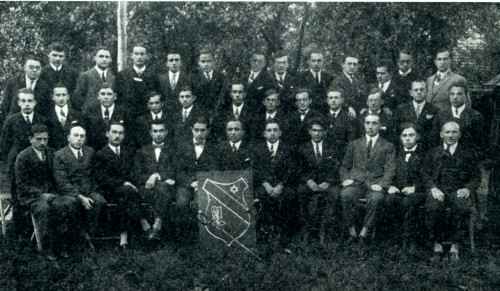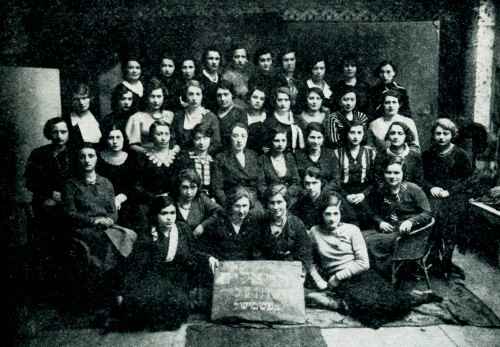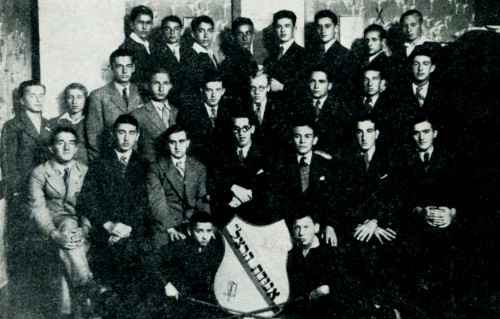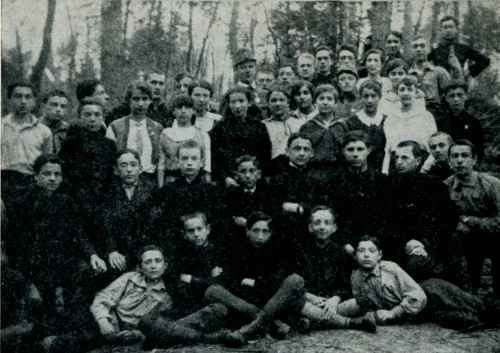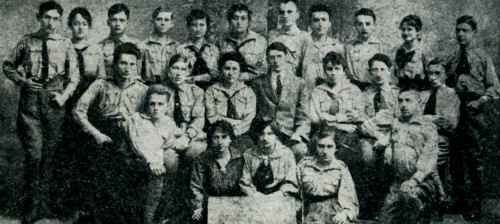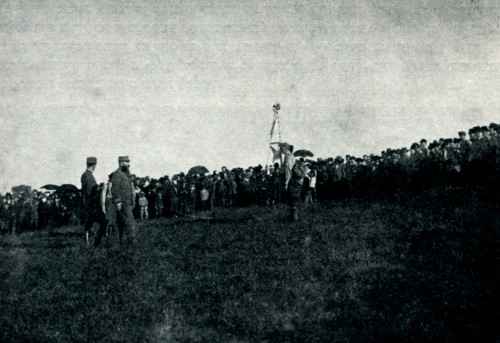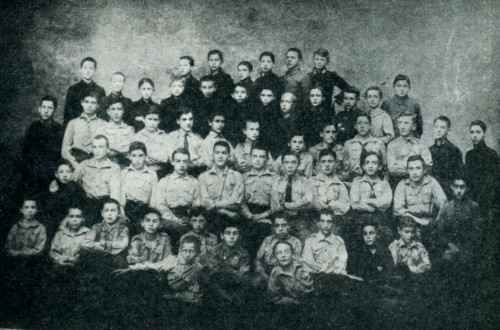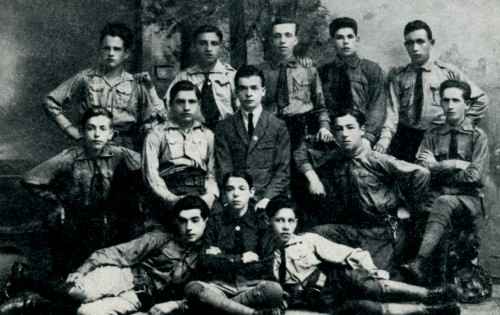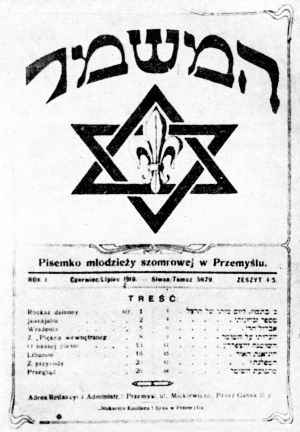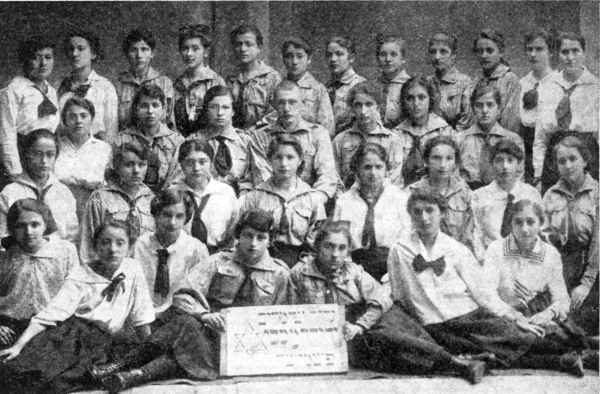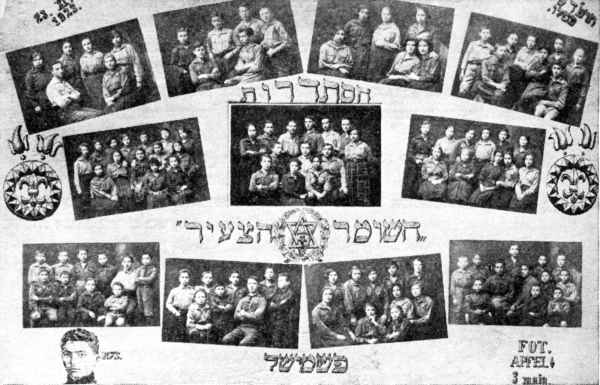[Page 264]
Zionist Youth Movements in Przemyśl
The Renewed “Agudath Herzl” [i]
(1925-1939)
by Y. A.
The activities of “Agudath Herzl” ceased between 1921 and 1925. The older members went their own ways, whether to finish their schooling or to make a living. The graduates of the post-war years went away to universities and the town emptied out of its academic youth. In April 1925, when many of the students returned from their university towns, a renewal of “Agudath Herzl” became possible. Among the initiators of the renewed society we should mention Shimon Mieses, Matityahu Schweber, Zvi Rubenfeld and Yosef Altbauer. They were joined by students from the years 1921 – 1924.
The conditions under which the renewed society developed were completely different than those of the group from 1904.
|
|
“Agudath Herzl,” 1926
First row from right: Rebhun, Schweber, Nagel, Trau, O. Tannenbaum, Guttmann, Horn, Mieses, Landau, Sima, Gottfried
Second row from right: Kupfer, Rinde, J. Altbauer, Nussbaum, Gitter, Low, Laub, Treibetz, Feldhof, Kohn, Marienstrauss, I. Licht
Third row from right: Miltau, S. Licht, Ekiert, Brettholz, Streifer, M. Altbauer, Astel, Krys, S. Tannenbaum, Rubenfeld, Rebhun, Salzmann, Pohorille |
[Page 265]
Przemyśl had long since become a Zionist town and, during and after the war, hundreds of young Zionists grew up and were educated, especially in the national scouts movement “Hashomer HaTzair” (the character of this movement was completely different than today's “Shomer HaTzair”). From these “Shomrim” came most of the “Agudath Herzl” members in its new incarnation.
The role of “Agudath Herzl” was to educate Zionist academic youth and provide it with the most appropriate organizational framework, and to harness it to the yoke of Zionist discipline and activity. In fact, there was great value in the collective framework, which attracted many of the independent youths. Another merit of the “Agudath Herzl” of those days, was that Zionism had long since taken its first steps and the ideological differentiation process within the Zionist camp had come a long way. Among the learning youth too, there were many who leaned towards one direction or the other of Zionism. The strength of the society framework was that it managed, within a certain period of time, to include members with tendencies to all streams of Zionism. These contradictions helped to deepen the ideological aspect of the society's work.
There were many varied activities which needed to be carried out.
In addition to the social aspect (parties, excursions and so forth), Agudath Herzl performed all the large and daily activities of the Zionist movement during that time: from extremely active assistance to the national funds, distribution of shekalim, and organizational duties within the local general Zionist Organization, to the “high politics” in local and national institutions.
|
|
| “Herzliya” Academic Women's Union, 1933 |
[Page 266]
At the initiative of “Agudath Herzl,” the popular Zionist youth organization “Achva” [fraternity] was founded in Przemyśl and the society members served as its presidents for a long time.
Furthermore, “Agudath Herzl” established a society of academic women, “Herzliya,” which over the course of time became an almost inseparable part of the society.
Much attention was given to the issue of academic reservists among the gimnazjum youth, particularly during the last years before the war, when the society handled the organization of high-school students.
It is also worth mentioning that the members worked hard (in 1933) to found an artisans' organization, and guided them in Zionist work and trained many of them for aliya.
Especially noteworthy was the cultural work conducted by “Agudath Herzl,” both internally and externally. In “Agudath Herzl,” unlike in other societies of its kind, the main work was not that of “the warrior” but rather that of “the writer.” Fortunately, some of the members who resided permanently in Przemyśl made sure that attention was devoted not only to daily work, but to the spiritual-cultural work, discussions of Zionist and general Jewish problems, Hebrew and Yiddish literature and books from world literature which dealt with the Jewish problem. “Agudath Herzl” was one of the few organizations in Galicia whose parties were held not only in Polish, but also in Hebrew.
And in terms of outreach: “Agudath Herzl” founded a popular university in which, besides the guest lecturers, many of the lecturers were its own members. This work also incorporated the surrounding areas of Przemyśl, and many members visited nearby villages to give lectures, and so forth.
The popular university was comprised of four branches: Jewish Sciences (lecturers: A. Katz, P. Arbesman[a]);
[Page 267]
General History (lecturer: A. Tennenbaum); Natural Sciences (lecturer: M. Schlisselberg); Social Sciences (lecturer: Dr. Y. Grobtuch).
In 1926 it had 200 students.
In 1930, “Agudath Herzl” hosted a conference of the union of academic societies in Poland, “Yardenia.” It was attended by 30 delegates from around the country. The lecture on cultural work was delivered by one of the talented “Agudath Herzl” members, Norbert Halpern. His lecture was published in full in the Zionist press and served as a platform for the cultural activity of the academic societies.
Over time, “Agudath Herzl” completely abandoned national politics, landespolitik, and devoted all its energies to Eretz Yisrael issues and aliya training. Much impetus in this direction was given by the visits of our brothers from Eretz Yisrael (Goldstein and Luft). From the days of the first “Maccabiah,” the members began to make aliya and in the years 1932-1939 a significant number made aliya. Some of them went to rural areas (kevutzot and kibbutzim) and some found their place in the towns. The war put an end to this aliya, and only a few were able to make aliya even during the war.
In 1944 and 1954 the members of “Agudath Herzl” in Israel celebrated the fortieth and fiftieth anniversaries of the society's establishment. Out of almost 200 members who belonged to the society during the years of its existence, some 40 members (20%) took part in the gatherings, from among the first founders of the society, the graduates of 1904, all the way to the youngsters from 1939. This was evidence that the idea formed by “Agudath Herzl” had bore fruit. During the 35 years of its existence, “Agudath Herzl” recorded a glorious episode in the history of Przemyśl Zionism. Its members are scattered in all corners of the land and occupy respectable positions in the nation's life, whether as senior officials, in institutions, in kibbutzim, in career army positions, in the private sector and in the liberal professions. They all drew strength and encouragement from the Zionist tradition of “Agudath Herzl.”
[Page 268]
The History of “Hashomer Hatzair” in Przemyśl
Y.A.
The “Shomer” (“Jewish Scouting”) movement was established in Lvov by Henryk Sterner. In 1914, when word of the movement reached Przemyśl, the local branch was opened. A small group of 10 boys, led by Kuba (Yakov) Spachner, constituted the first core group of Jewish scouts in town. When World War I broke out, the group disbanded and was not resurrected until the end of 1915, in its new form, after Galicia was partially liberated from the Russian occupation.
The survivors of the war who returned from Vienna, the birth town of the renewed “Hashomer” movement, founded the movement's cell in Przemyśl. In November 1915, the first groups of students, male and female, from the Polish gimnazjums in town were organized. At first, they were only from the fifth year. The cell was directed by “the Viennese” – David Weissberg, Eliyahu Bien, Dina Torbe (Dishka), and Moshe Hacke (now Dr. Moshe Oren, a teacher at Geula High school in Tel-Aviv).
The plan of action, which was carried out according to “The Guide for Shomer Leaders” (Poradnik kierownikow szomrowych), published in Vienna. It combined the programs of the Jewish Zionist youth with the Jewish scouting principles.
The first group, “The Crow,” guided by Menachem Zwanziger (now in Haifa) began its work energetically and as early as February 1916 had managed to pass the test, both in scouting and in Jewish studies (Hebrew, Jewish History, and Eretz Yisrael studies).
[Page 269]
As the number of members in this group increased, it issued forth the first counselors of the movement in town, who were: Benjamin Brettholz, Lipa Stempel, Moshe Warth, Yosef Altbauer (author of these lines), Moshe Schlisselberg, Shiko Rinde, David Zwanziger. The first female counselors were: Leah Siegel, Mania Halpern, Frieda Rebhan. The movement grew and in 1917 it encompassed approximately 80% of the town's Jewish school youth. The number of members reached 500 boys and girls. The cell was comprised of two regiments: The Judah Maccabi Shomrim regiment, and a regiment of female shomrot. It was considered one of the largest in Galicia. It is worth emphasizing that the activity was conducted underground, as the gimnazjum students were strictly prohibited from belonging to any movements. Any transgressor could be expelled from school. During the activities, a lookout point often had to be assigned so that the students could be warned about any teachers passing by. Several of the Shomrim were persecuted by the teachers, when they found out about the movement. When we returned from the excursions and field activities, we did not dare enter the town, but rather scattered around its peripheries and hid our scouts hats beneath our coats.
|
|
The first instructors, 1918
First row from left: Pillersdorf, Imbermann, Kraut, Sack, Sobel
Second row from left: Stempel, Weissberg, Halpern, Luft, Rebhan, Brettholz, Warth
Third row from left: Rinde, Teitelbaum, Altbauer, Low, Herzig, Bien, Dortort, Astel, Brand, Poppers, Zwanziger |
This situation changed in 1918. We felt that we were so strong, and the movement was so large, that we were no longer afraid to walk together all the way to the center of town.
The first dwelling of the movement was in the basement of the Torbe house at 14 Wladycze Street. We then moved to the Singer house on Kopernika Street. When the numbers increased this location became too small, and the movement relocated to the Mieses house at 5 Mnisza Street, to a spacious apartment with several rooms, and from there to the final location on Snigurskiego Street, in the Rubinfeld house, a small house with a large courtyard. The center was located here for many years, and other youth associations used it for their cultural activities too.
As the movement grew, the number of Hebrew speakers among the youth also increased. The Hebrew language teachers included Zvi Diesendrock, who served in the Austrian army in Przemyśl, Tafet and his sister.
The swearing-in ceremony of the first Shomer groups and the inauguration of the movement flag, which was held
[Page 270]
on July 23, 1916 (the day of Herzl's death) at Pikulice became a celebration day for the Zionists in town. Hundreds of guests from the town and Shomer groups from nearby Jarosław took part in the ceremony. The patrons of the celebration were: Przemyśl's military chaplain, Dr. Yosef Mieses, who dedicated the flag, and the movement patron – Zvi Luft. They both appeared in the military uniform of Austrian officers. This appearance of theirs was not without consequence: they were both court-marshaled. One must not forget that during that period, the Austrian authorities did not look kindly upon Zionism and the Zionists.
|
|
Pikulice, July 23, 1916
The flag raising ceremony by the Army Chaplain Dr. Joseph Mieses and Zvi Luft |
The second swearing-in ceremony was held on August 5, 1917, with the presence of the national Shomer leadership head, Eliezer Riger (who later became a professor at the Hebrew University and the Director General of the Ministry of Education and Culture, and died in Israel). Two of the town cell's leaders, Eliyahu Bien and Dina Torbe, were also members of the central leadership.
In July of 1918, the first conference of the movement counselors was held in Tarnowa Wizna, under the title: “The First Assembly of Shomer Managers in Galicia and Bukowina.” The Przemyśl cell sent a large delegation. Cell member Frieda Rebhan delivered an important lecture on the educational methods of the girls in the movement. This assembly determined the new paths of the movement, which was called from then onwards “Hashomer Hatzair,” and the new salute was determined: “Chazak Ve'Ematz” [“Be strong and of good courage!”]. The old Shomer salutation, “Take Heed,” was gone.
After the Tarnowa assembly, the cell began its Zionist activity with even more fervor. All Zionist activity in the town during that period was in fact connected with Hashomer Hatzair. During November 1918, upon the disintegration of the Austrian monarchy,
[Page 271]
the adult Shomrim took part in the defense system organized in town. From March 1919, the cell published a newsletter in Polish and Hebrew, entitled “Mishmar Ha'San,” [The San Guard] which later became “Hamishmar.”
|
|
| The first group of working youth “Hashomer Hatzair” |
[Page 272]
[Page 273]
|
|
| “The Shomer Hatzair Organization” – various group photographs dated November 23, 1923 |
[Page 274]
The first group of the older counselors left the town to study in the university towns. A new generation replaced them – Adam Dortort, Zvi Rubenfeld, Moshe Brand, Moshe Sobel, Haim Lev, M. Pillsdorf[b], Golda Herzig, Shinka Poppers, Esther Sack, Runia Kraut, Lorka Imbermann. The movement preached fulfillment of ideals and pioneering, and nurtured the idea of social justice – for the time being without basing it on the theories of Marx – these ideals were enthusiastically adopted by the movement members. At the end of 1919 the cell also recruited working youth who were not among the gimnazjum students. Altbauer, Betka Andermann and Haya Kalgsbald (Getz) were the first counselors who brought the artisans' apprentices into the movement, educated them and preached Zionism and pioneering. This was a change from the custom whereby only boys and girls from the high schools were recruited to the movement.
The Shomer Hatzair education bore fruit. In 1920 the first group of Shomrim made aliya. The first pioneers from Przemyśl were Shlomo Goldstein, Nathan Siegel, Zvi Fink (later died in Israel), M. Orner, David Zwanziger, Yosef Wirth[c], Ms. Schein, Yitzhak Astman, Malka Glanzberg, Altbach, Zvi Bauer, and Devorah Slik-Kushnir. The Shomer's spiritual patron, Zvi Luft, also made aliya with them.
In 1924 the movement determined its new path, according to which it ceased being a national scouts movement, and demanded from its members personal pioneering and realization of the ideals. The number of members decreased a little. At the head of the cell, which had become a medium sized cell, stood Michael Weisinger[d] (now Dr. Michael Ziv, a department director at the Ministry of Education and Culture). The cell was active as a regional center. The adults left the town, and some of the Shomrim abandoned the movement for ideological reasons, since the leftist tendencies had grown stronger in the movement. The leadership passed to younger hands. Bronek Torbe, who died in 1926, just before he was to make aliya, and his friend A. Tischler (Tischke, who died in Kibbutz Merchavia a short time after making aliya), were the movement leaders in town. They were later replaced by Olek Hausman. Due to the leftist leanings, the movement suffered from persecution by the Polish authorities. Every so often, they conducted searches for clandestine literature. Despite the difference in outlooks, the civilian public supported the movement, both spiritually and materially. The Society to Benefit Hashomer Hatzair was directed by the general Zionist eng. Henryk Bazar.
The movement merged with “HeChalutz” and continued its fulfillment. During 1930-1939, the average number of cell members was between 80 and 100.
Once in a while, the cell published a periodical about the movement's way of life, and the problems involved in determining its path. They are now kept in the Shomer Hatzair archives in Merchavia, and they are: “Nitzotzot” [“sparks”] (1931); “Olameinu” [“our world”] (1926), “Hatzair” [“the young one”] (1930); “Anachnu” [“us”] (1922).
In these pamphlets, the desire and aspiration of these delicate souls to a life of labor in Eretz Yisrael and the realization of Zionist and Socialist ideals, is a common thread.
Only a handful of these wonderful youths were able to realize their dreams, and they are on kibbutzim and other places of work in Israel.
Original Footnote:
- Adapted from the “Agudath Herzl” 40th Anniversary pamphlet. Back
Coordinator's Footnotes:
- Arbesman, spelled ארבסמן. This is one of those situations where there may have been a possible spelling error (Abramson?). This name could have been also spelled Abersman, Ebersman Back
- Pillsdorf. Spelled פילסדורף. This is probably a spelling error (Pillersdorf?). This name is spelled פילרסדורף (for occurance on page 274) in the Yizkor book's index. Back
- Wirth. Spelled ורט. This is an example of different spelling variations of the same name. Later in this chapter the name is spelled ווירט Back
- Weisinger. Spelled ויזינגר Back
This material is made available by JewishGen, Inc.
and the Yizkor Book Project for the purpose of
fulfilling our
mission of disseminating information about the Holocaust and
destroyed Jewish communities.
This material may not be copied,
sold or bartered without JewishGen, Inc.'s permission. Rights may be
reserved by the copyright holder.
JewishGen, Inc. makes no representations regarding the accuracy of
the translation. The reader may wish to refer to the original material
for verification.
JewishGen is not responsible for inaccuracies or omissions in the original work and cannot rewrite or edit the text to correct inaccuracies and/or omissions.
Our mission is to produce a translation of the original work and we cannot verify the accuracy of statements or alter facts cited.
 Przemyśl, Poland
Przemyśl, Poland
 Yizkor Book Project
Yizkor Book Project
 JewishGen Home Page
JewishGen Home Page
Yizkor Book Director, Lance Ackerfeld
This web page created by Osnat Ramaty
Copyright © 1999-2026 by JewishGen, Inc.
Updated 16 Mar 2025 by LA
